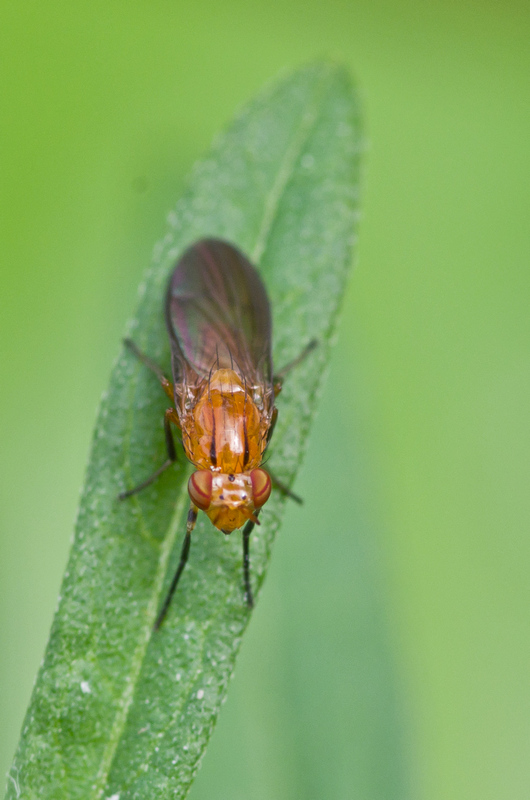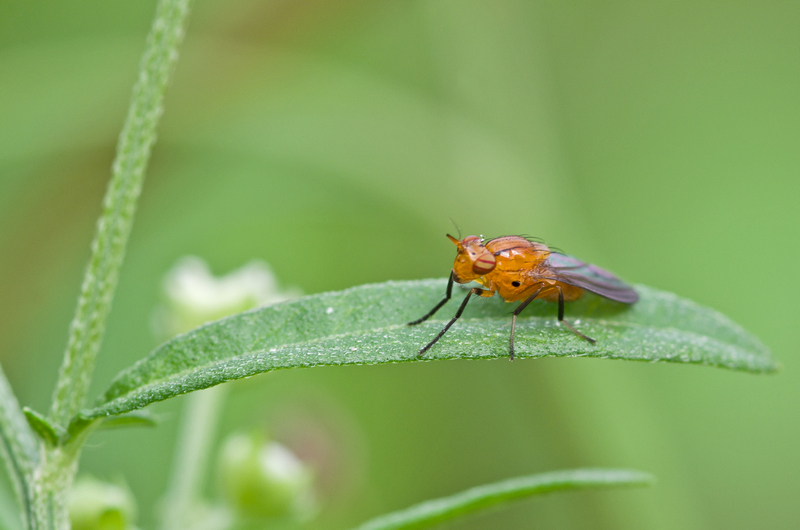Diptera.info :: Identification queries :: Diptera (adults)
Who is here? 1 guest(s)
|
unknown fly from Chiapas
|
|
| DJHiker |
Posted on 16-03-2015 14:18
|
|
Member Location: Utrecht, NL Posts: 429 Joined: 24.10.13 |
I spotted this small fly (length approx. 4mm) in Lacanja, Chiapas province, Mexico, near the border with Guatemala. Altitude: <500m DJHiker attached the following image:  [171.57Kb] |
|
|
|
| DJHiker |
Posted on 16-03-2015 14:20
|
|
Member Location: Utrecht, NL Posts: 429 Joined: 24.10.13 |
lateral view
DJHiker attached the following image:  [181.74Kb] |
|
|
|
| Paul Beuk |
Posted on 16-03-2015 15:28
|
|
Super Administrator Location: Netherlands Posts: 19363 Joined: 11.05.04 |
Looks like Sciomyzidae
Paul - - - - Paul Beuk on https://diptera.info |
| DJHiker |
Posted on 17-03-2015 01:37
|
|
Member Location: Utrecht, NL Posts: 429 Joined: 24.10.13 |
Hi Paul, Thanks for pointing out the family. It is a large family, so I guess for neotropical species it is difficult to be more specific with just a photo to rely on. Regards, David |
|
|
|
| Dmitry Gavryushin |
Posted on 11-06-2015 09:39
|
|
Member Location: Moscow region, Russia Posts: 3308 Joined: 17.10.05 |
An answer from Lloyd Knutson: The photo sent by D.J. Hiker on 16.3.2015 does not look like a sciomyzid because it seems to lack pre-apical tibial setae and it seems to have a clypeus. The color pattern of thorax and legs is unlike any sciomyzid I have seen |
|
|
|
| Paul Beuk |
Posted on 11-06-2015 11:12
|
|
Super Administrator Location: Netherlands Posts: 19363 Joined: 11.05.04 |
Then we revert back to Lauxaniidae. 
Paul - - - - Paul Beuk on https://diptera.info |
| John Carr |
Posted on 11-06-2015 12:14
|
|
Member Location: Massachusetts, USA Posts: 10172 Joined: 22.10.10 |
I see a preapical on the fore tibia. I think Lauxaniidae. I think I see an inclinate pair of fronto-orbital bristles. At least Neogriphoneura and Camptoprosopella have that character, but they lack eye bands. I don't have time this morning to check what else lives in Mexico. |
| John Carr |
Posted on 12-06-2015 03:56
|
|
Member Location: Massachusetts, USA Posts: 10172 Joined: 22.10.10 |
Start here, quoting the description from Curran (Bulletin of the American Museum of Natural History 80(3):51-84 1942): Physegenua ferruginea Schiner SCHINER, 1868, Novara, p. 277. Ferruginous, the front with three black spots, mesonotum with two or four obscure, narrow, darker vittae; mesopleura with a subrectangular, opaque black spot below the bristle; apical abdominal segnment with median black spot; anterior tibiae and tarsi, an incomplete preapical band on the front femora and the posterior tibiae blackish, the middle tibiae mostly brownish. A series of both sexes from Brazil. It is possible that more than one species will agree with the original description. The opaque black spot on the pleura usually partly surrounds the bristle, and usually only the dorsocentral vittae are distinct. They are rarely brownish. |
| DJHiker |
Posted on 18-07-2015 12:51
|
|
Member Location: Utrecht, NL Posts: 429 Joined: 24.10.13 |
Hi John, Thanks for your reply. Curran’s description of Physegenua ferruginea does not seem to mention the banded eyes (at least not included in the part you quoted)? David |
|
|
|
| John Carr |
Posted on 19-07-2015 04:21
|
|
Member Location: Massachusetts, USA Posts: 10172 Joined: 22.10.10 |
DJHiker wrote: Hi John, Thanks for your reply. Curran’s description of Physegenua ferruginea does not seem to mention the banded eyes (at least not included in the part you quoted)? David Descriptions of Lauxaniidae often omit mention of eye bands. If you want a definitive answer, you'll need to contact Steve Gaimari or another expert. |
| Steve Gaimari |
Posted on 03-08-2015 21:17
|
|
Member Location: Sacramento, California, USA Posts: 169 Joined: 08.10.04 |
Glad you contacted me to take a look at this! It got me looking at some Physegenua. At first glance, I likely would have called this Physegenua ferruginea too, partly since it lacks markings on the face. But after looking at a bunch of specimens identified as P. ferruginea there is a strange thing I noticed. First, the type - it has mostly clear wings (only darkened along the costa) and the legs aren't nearly so dark. Looking at series of specimens, it seems the ones identified as this species from Mexico have very dark wings and very dark legs, as in the one you photographed. So, I took a look at the literature. After the description of P. urina (Giglio-Tos, 1893), Williston (1894) said that P. urina is very likely the same as P. ferruginea. I think that this idea was followed afterwards, although Giglio-Tos (1895) pointed out that he believed that to be incorrect. One of the differences is that P. urina has very dark wings. I have not seen the type of P. urina, but I believe your fly is that species, which is described from Mexico. I think I need to see this type. 
Steve Gaimari Plant Pest Diagnostics Lab, CDFA 3294 Meadowview Road Sacramento, CA 95832-1448, USA |
| DJHiker |
Posted on 06-08-2015 00:37
|
|
Member Location: Utrecht, NL Posts: 429 Joined: 24.10.13 |
Hello Steve, Thank you very much for your response and for your help in identifying this intriguing species. Best regards, David |
|
|
|
| Jump to Forum: |















